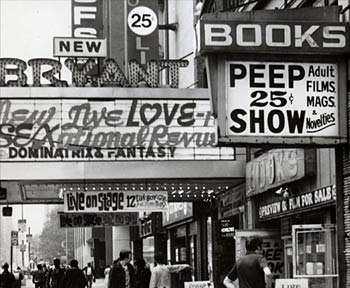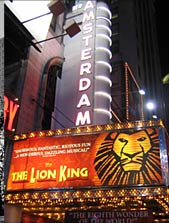Essay
Resurrection of 42nd Street
There’s something about New York City mayors and Broadway musicals that makes them go together. Irving Berlin spoofed City Hall in his 1932 “Face the Music” and Peter Stuyvesant, Jimmy Walker, Fiorello La Guardia, and Edward Koch each became lead characters in Broadway musicals (technically, Koch was Off Broadway).

An aerial view of Times Square.
But it took until March 23, 1973 for an actual New York mayor to appear on the boards. For one evening, John V. Lindsay, nearing the end of his tenure, sang “My City” — a backhanded paean to the charms of New York — in a performance of Cy Coleman’s “Seesaw,” because of his ostensible resemblance to the show’s star, Ken Howard. Broadway seemed to like Lindsay, and he considered himself a patron of the arts. But Lindsay’s interest in reclaiming Times Square had far more to do with increasing tax revenue than with artistic patronage of the theater. His desire to encourage development in the theater district would spin out, over the next 30 years, into a strange and tangled confluence of politics, economics, public relations, greed, and ego, where alliances shifted constantly and decisions made in City Hall conference rooms could affect the scenic design of a Broadway show.

Times Square at night.
Lindsay’s most complicated artistic legacy came under the guise of “tax abatements”: financial incentives to encourage investment and development in the Times Square area. The abatements allowed developers to build new office buildings in exchange for huge tax breaks from the city. One provision forced the developer to add a theater on the ground floor of a new building as part of the deal, and in the 1970s, the Minskoff, the Uris (later renamed the Gershwin), and the renovated Circle in the Square were added to the Broadway landscape, the first new theaters built since the beginning of the depression. Unfortunately, they were cheerless and charmless, and Times Square got seedier and sleazier; when dire financial straits hit the city in the late 1970s, they brought an end to this brief period of redevelopment. By 1977, even the famous “zipper” sign that spun out headlines along the Times Tower for 50 years had turned out its lights.
When Atlanta hotel magnate John Portman had contacted City Hall in the late ’70s about building a multistory hotel on Broadway, between 45th and 46th streets, Mayor Ed Koch put the project on a fast track.
Now, this area in the ’70s was a sewer. This was the den of pornography, prostitution, felony crime, drug dealing — you name it. And along came Marriott in about 1973 and they wanted to build a new hotel here. Well, that hotel was advocated by everybody in this business, including us. We thought it represented a major signal that the area was alive and well, and so did everybody else.
— Gerald Schoenfeld, the Shubert Organization

The peep shows and porn theaters that lined the streets of Times Square.
But the construction of the Marriott necessitated the razing of five theaters (including two beloved by the theater community — the Morosco and the Helen Hayes) on that block, a decision that would obsess and polarize the community for years. Despite many protests and several court stays, the demolition began on March 22, 1982, and the Marriott Marquis, as it came to be called, is today the most successful hotel in America.
None of these maneuvers helped 42nd Street itself. By 1990, however, under the new administration of David Dinkins, an organization called the New 42 was constituted to try to resurrect the street one more time. The New 42 put its energy into remaking the area into a center for legitimate theater, something it hadn’t been since before the depression. The Victory Theater, now an abandoned wreck, had begun life in 1900 as the Theatre Republic, eventually turning into both a burlesque house and, later, a porn theater. The New 42 wanted to transform it into — of all things — a theater for young audiences. As plans for that began in 1992, focus turned to the New Amsterdam at the corner of 42nd Street and Seventh Avenue, Ziegfeld’s grand aerie. Defunct as a legitimate theater since 1937, the New Amsterdam too had suffered the depredations of decay, neglect, and specious tenants.
The New Amsterdam had been dangled in front of developers and producers for years by the city, but no one had the courage to seal the deal. But after the success of the stage version of “Beauty and the Beast” in 1992, the CEO of the Walt Disney Company, Michael Eisner, was intrigued at the possibility of finding a theatrical venue that Disney could own, rather than relying on renting from other theater owners. A chance meeting on an airplane with New 42 chairperson Marian Heiskell convinced Eisner to take a look at the ruins of Ziegfeld’s temple for himself.

The New Amsterdam Theater.
In April 1993, Eisner began a series of cautious and elaborate negotiations with the city to restore and rent the New Amsterdam. The cost would be an extensive $32 million, with $24 million covered by the city in the form of loans that were extremely advantageous to Disney; the company itself committed $8 million, with a carefully monitored schedule of overages. The terms of the lease would extend for 49 years. For reporters, critics, and mavens, the idea of Mickey Mouse on 42nd Street was a hilarious irony. For Eisner, it was a business decision fraught with catastrophic risk: what would it mean for a brand name of such wholesome family values to set up shop on the most decadent city block in the western world? He spoke with the new mayor, Rudolph Giuliani, who had made his career as a federal prosecutor crusading against the mob.
I had a little concern about the adjacent nightlife, and he [Giuliani] looked me in the eye and he said, “It’ll be gone,” and I said, “Mr. Mayor, you know there is the American Civil Liberties Union, and I mean, they’re just not gone.” He said, “Look me in the eye.” And I said, “What?” He said, “Look me in the eye.” I said, “Okay.” He said, “They will be gone.” Scared me. I guess[ed] they were going to be gone. So that was that, and we said yes.
— Michael Eisner
Disney’s announcement that it would go ahead with the renovation of the New Amsterdam in the winter of 1994 opened the floodgates of redevelopment, just the way New 42 intended. By the end of 1995, the New Victory Theater for young audiences, beautifully restored, had opened. Even more remarkably, there was a cappuccino bar next door. Retail outlets began to sign leases in the Times Square area, new bright and elaborate electronic signage began appearing in the theater district for the first time since the beginning of World War II, and several business and communications firms announced plans to build new offices on or adjacent to West 42nd Street. Even the “zipper” was back, courtesy of NEW YORK NEWSDAY.
In the fall of 1997, Disney opened “The Lion King” at the New Amsterdam, the first new musical there since Sigmund Romberg’s “Forbidden Melody” in 1936. The show got wildly enthusiastic reviews, as did the theater itself, the result of a loving four-year restoration masterminded by architect Hugh Hardy. Later that year, the Ford Motor Co., as a corporate sponsor, paid for the massive renovation of the Lyric and Apollo theaters, which merged the two defunct spaces into one enormous musical house. In 1998, the Ford Center for the Performing Arts debuted with the musical version of “Ragtime.” That same year, the Empire Theatre on 42nd Street, which had housed musicals and burlesque shows, was physically rolled by engineers 168 feet farther west to begin life again as the 25-theater AMC multiplex. The renovation of the Selwyn Theater as the American Airlines Theatre (a home for the Roundabout Theater Company) and the addition of a multistudio rehearsal space next door burnished the transformation of the new 42nd Street.
There are moments in its history when the theater district is rudely awakened to the fact that it sits on some of the most desirable real estate in the free world. In 2004, you can exit the revival of “42nd Street” at the Ford Center and walk right onto the real 42nd Street. The show sings of “naughty, bawdy, gaudy, sporty 42nd Street,” but the real thing is one of the most artfully developed urban centers in America.
Photo credits: Photofest; Nils Hanson; Peter Tierney (© Disney); the Library of Congress, Prints and Photographs Division, Historic American Buildings Survey or Historic American Engineering Record (HABS, NY,31-NEYO,91-1); the Library of Congress, Prints and Photographs Division, Gottscho-Schleisner Collection (LC-USZC4-4736 DLC); and Corel.

